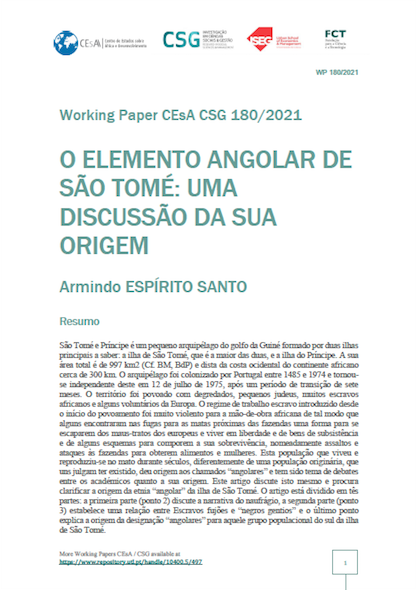Working Paper 180/2021: O Elemento Angolar de São Tomé: Uma discussão da sua origem

Title: Working Paper 180/2021: O Elemento Angolar de São Tomé: Uma discussão da sua origem
Author(s): Santo, Armindo Espírito
Publication Date: 2021
Publisher: ISEG – CEsA/ CSG
Quotation: Santo, Armindo Espírito (2021). "O elemento angolar de São Tomé: uma discussão da sua origem". Instituto Superior de Economia e Gestão – CEsA/ CSG - Documentos de Trabalho nº 180/2021.
Abstract: São Tomé and Príncipe is a small archipelago in the Gulf of Guinea formed by two main islands, namely: the island of São Tomé, which is the larger of the two, and the island of Príncipe. Its total area is 997 km2 (Cf. BM, BdP) and is approximately 300 km from the west coast of the African continent. The archipelago was colonized by Portugal between 1485 and 1974 and became independent on July 12, 1975, after a seven-month transition period. The territory was populated with exiles, small Jews, many African slaves and some volunteers from Europe. The slave labor regime introduced since the beginning of the settlement was very violent for the African labor in such a way that some found in the escapes to the forests close to the farms a way to escape the mistreatment of the Europeans and live in freedom and subsistence goods and some schemes to compose their survival, namely assaults and attacks on farms to obtain food and women. This population that lived and reproduced in the bush for centuries, unlike an original population, which some believe to have existed, gave rise to the so-called "Angolas" and has been the subject of debates among academics as to its origin. This article discusses this and seeks to clarify the origin of the “Angolar” ethnic group on the island of São Tomé. The article is divided into three parts: the first part (point 2) discusses the narrative of the shipwreck, the second part (point 3) establishes a relationship between fugitive slaves and “Black Gentiles” and the last point explains the origin of the designation “Angolas ” for that population group in the south of the island of São Tomé.
Identifier: http://hdl.handle.net/10400.5/20867
Category: Working paper
Abstract:
São Tomé and Príncipe is a small archipelago in the Gulf of Guinea formed by two main islands, namely: the island of São Tomé, which is the larger of the two, and the island of Príncipe. Its total area is 997 km2 (Cf. BM, BdP) and is approximately 300 km from the west coast of the African continent. The archipelago was colonized by Portugal between 1485 and 1974 and became independent on July 12, 1975, after a seven-month transition period. The territory was populated with exiles, small Jews, many African slaves and some volunteers from Europe. The slave labor regime introduced since the beginning of the settlement was very violent for the African labor in such a way that some found in the escapes to the forests close to the farms a way to escape the mistreatment of the Europeans and live in freedom and subsistence goods and some schemes to compose their survival, namely assaults and attacks on farms to obtain food and women. This population that lived and reproduced in the bush for centuries, unlike an original population, which some believe to have existed, gave rise to the so-called “Angolas” and has been the subject of debates among academics as to its origin. This article discusses this and seeks to clarify the origin of the “Angolar” ethnic group on the island of São Tomé. O Elemento Angolar de São Tomé: Uma discussão da sua origem is divided into three parts: the first part (point 2) discusses the narrative of the shipwreck, the second part (point 3) establishes a relationship between fugitive slaves and “Black Gentiles” and the last point explains the origin of the designation “Angolas ” for that population group in the south of the island of São Tomé.
Quotation:
Santo, Armindo Espírito (2021). “O elemento angolar de São Tomé: uma discussão da sua origem”. Instituto Superior de Economia e Gestão – CEsA/ CSG – Documentos de Trabalho nº 180/2021.





